Biophysical Measurements
-
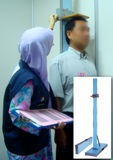
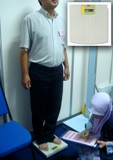

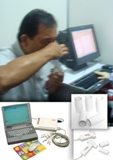
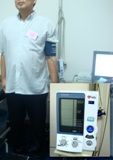
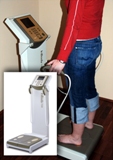 1Harpenden (Portable Stadiometer)Height measurement2
1Harpenden (Portable Stadiometer)Height measurement2SECA (880 Digital Personal Scale) Weight measurement3SECA (200 Girth Measuring Tape) Waist & hip measurement4Schiller (AT-104) Electrocardiogram measurement5Schiller (SP-260) Spirometry measurement 6Omron (HEM-907) Blood pressure measurement 7Biospace (Inbody 720) Body composition analysis Prosedur Operasi Standard
- Pengukuran Antropometri
- Pengukuran Tekanan Darah
- Pengukuran Elektrokardiogram
- Pengukuran Spirometri (Ujian Fungsi Paru-Paru)
- Pengukuran Anggaran Umur Arteri (Vasera)
- Pengukuran Komposisi Badan (Inbody)
Pengukuran Komposisi Badan (Maltron)
-
Introduction
Have you ever measured your body? Or did you know how much that your physique has changed across the time? For the project participants, some of the benefits of measuring body include:
- You will know your measurements of weight, height as well as waist and hip circumferences
- You will know your Body Mass Index (BMI) which could be calculated by dividing weight in kilograms by the square of their height in metres (kg/m2)
- The procedures are very safe and only certain tools were used to carry out the measurements.
What is anthropometry and how does it work?
Anthropometry is the scientific study of the measurements and proportions of the human body. It gives as the information related to height, weight as well as hip and waist circumferences. The following are some of the examples of the anthropometric measurement carried out at The Malaysian Cohort.
What is the preparation for anthropometric procedures?
Height measurement
- Stand upright on the base plate of the stadiometer.
- Face forward and the heel section should be touching the measuring rod.
- Chest ribs should be upward and outward (for example during inhalation).
- As many as three measurements were recorded.
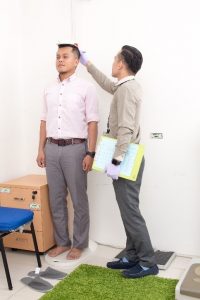
Image 1: The participant’s body posture when the height is being measured.
Weight measurement
- Please removed all accessories before weighting in order to get a more accurate measurement.
- Stand on a weighing scale according to the following requirements: looking forward, standing upright, hands on the side, motionless and breathing normally.
- As many as two measurements were recorded.
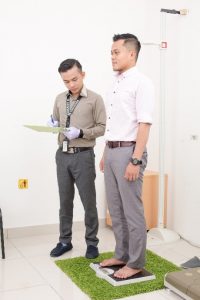
Image 2: The participant’s body posture when the weight is being measured.
Reference of body mass index (BMI)
BMI (kg/m2) Remark < 18.5 Underweight 18.5 – 24.9 Normal 25.0 – 29.9 Overweight / pre-obesity 30.0 – 34.9 Class 1 Obesity 35.0 – 39.9 Class 2 Obesity > 40.0 Class 3 Obesity Measurement of waist and hip circumferences
- Stand upright and breath normally
- The position of illiac cres was determined and as many as 3 measurement readings were recorded. Refer to Image 3.
- The position of hip was determined and the largest measurement reading was recorded as in Image 4.
- The measurement was taken at the level parallel to belly button.
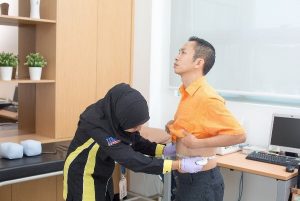
Image 3: Measuring waist circumference.
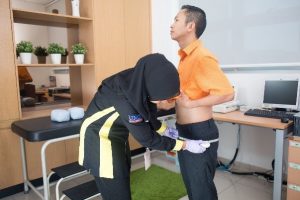
Image 4: Measuring hip circumference.
To get a more accurate result, you need to stay well-hydrated and there is not any food in your stomach (at least 3 hours prior to your last meal).
The results will be analysed and verified. After that, a printout of the results containing the information of height, weight, waist’s circumference, hip’s circumference, BMI and waist-hip ratio will be sent to the participants.
Note: This body composition analysis could be done every 3-6 months or annually to monitor the changes of parameters such as weight and BMI.
Who needs to carry out the test?
Anyone, who are interested to learn more about their body physique.
Pengenalan
Pernahkah anda mengukur tubuh anda? Atau pernahkah anda terfikir selama ini berapa banyak berlaku pertumbuhan pada tubuh anda? Antara kelebihan melaksanakan pengukuran ini adalah:
- Peserta akan memperoleh keputusan tinggi, berat dan ukurlilit pinggang & pinggul
- Peserta akan memperoleh keputusan Indeks Jisim Tubuh (Body Mass Index-BMI) iaitu nilai berat badan berbanding dengan ketinggian (kg/m2)
- Prosedur adalah sangat selamat. Hanya menggunakan beberapa peralatan untuk menjalankan ujian pengukuran
Apakah ANTROPOMETRI dan bagaimana ia berfungsi?
ANTROPOMETRI merupakan pengukuran struktur tubuh badan seseorang. Ia memberikan maklumat berkenaan tinggi, berat dan ukurlilit pinggang & pinggul. Berikut adalah contoh pengukuran Antropometri yang dijalankan di The Malaysian Cohort
Apakah persediaan bagi prosedur ini?
UKURAN TINGGI
- Berdiri tegak di atas platform stadiometer
- Bahagian tumit menyentuh tiang pengukur dan muka dihadapkan ke hadapan
- Tulang rusuk dada menaik (seperti menarik nafas)
- Bacaan diambil sebanyak 3 kali
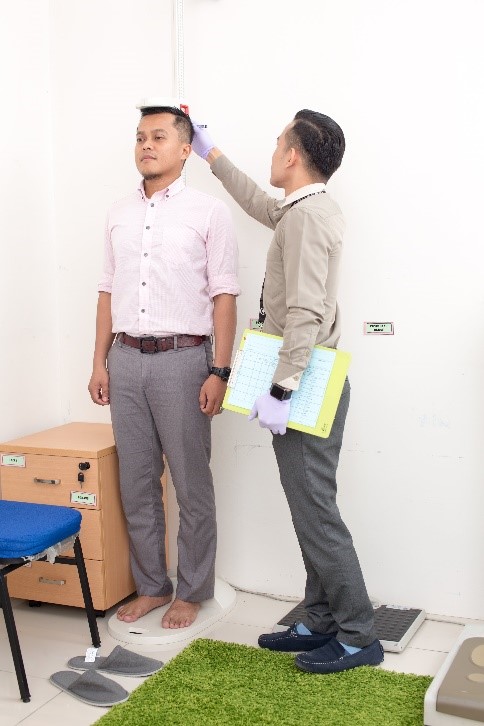
Rajah 1 : Posisi badan peserta semasa pengukuran tinggi dilakukan
UKURAN BERAT
- Sebelum ukuran berat direkod, semua aksesori perlu ditanggalkan untuk mendapatkan bacaan yang lebih tepat
- Berdiri di atas penimbang, perlu pandang ke hadapan, berdiri tegak, tangan di sisi, tidak bergerak dan bernafas seperti biasa
- Bacaan diambil sebanyak 2 kali
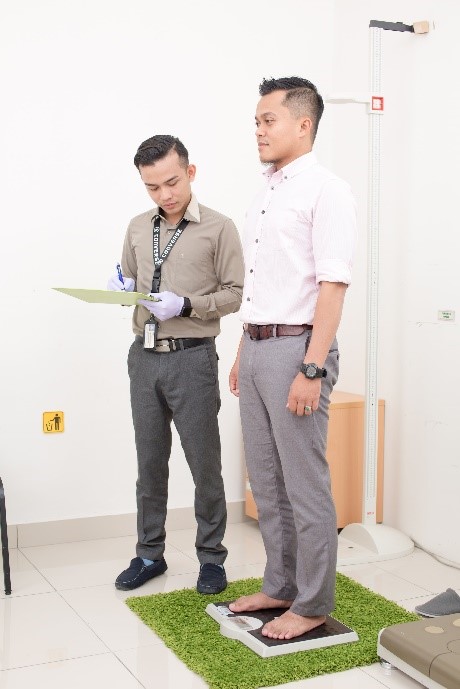
Rajah 2 : Posisi badan peserta semasa pengukuran berat dilakukan
RUJUKAN BAGI INDEKS JUSIM TUBUH / BODY MASS INDEX-BMI
BMI (nilai kg/m2) Ulasan < 18.5 Kurang 18.5 – 24.9 Normal 25.0 – 29.9 Berat badan berlebihan (pre-obes) 30.0 – 34.9 Obes (Kelas I) 35.0 – 39.9 Obes (Kelas II) > 40.0 Obes (Kelas III) (Rujukan : World Health Organization (2004))
UKURAN LILIT PINGGANG DAN PINGGUL
- Berdiri tegak, bernafas seperti biasa
- Menentukan kedudukan illiac cres, Bacaan diambil sebanyak 3 kali seperti rajah 3
- Menentukan kedudukan bacaan pinggul dengan mengambil bacaan terbesar seperti rajah 4
- Pita ukur pada titik tengah dan searas

Rajah 3 : Ukur lilit pinggang (Illiac crest)
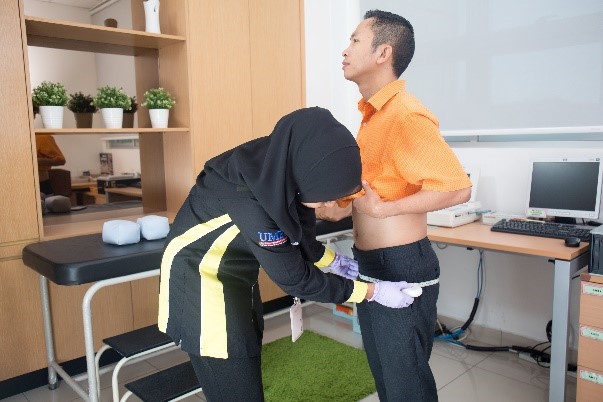
Rajah 4 : Ukur lilit pinggul
Bagi mendapatkan keputusan yang lebih tepat, anda perlu memastikan bahawa diri anda terhidrasi dengan baik dan tidak mempunyai sebarang makanan di dalam perut anda (sekurang-kurangnya 3 jam dari pemakanan terakhir anda).
Keputusan anda akan dianalisis dan disahkan. Selepas itu, cetakan keputusan yang mengandungi maklumat tinggi, berat, pinggal, pinggul, BMI dan nisbah pinggang pinggul akan dihantar kepada anda.
Nota: Analisis ini boleh dilakukan setiap 3-6 bulan untuk komposisi badan, atau setiap tahun jika anda ingin memantau perubahan pada parameter tertentu seperti berat dam BMI.
Siapa yang patut mengambil ujian ini?
Pengukuran ini boleh dijalani oleh sesiapa sahaja kerana ujian ini dapat memberikan maklumat terperinci tentang fizikal tubuh anda.
-
Introduction
Blood pressure is the strength of blood pushing against the sides of blood vessels when the blood being pumped by the heart to parts of the body.
Before the measurement starts, the participants will be asked if they have:
- Been certified to have high blood pressure or low blood pressure.
- Been under medication or not.
- Any other health problems.
What is blood pressure and how does it work?
Two values will be obtained from the blood pressure measurement, such as 120/80 mm Hg. The first value (120 mm Hg) referred to as systolic blood pressure, the total pressure in the arteries during the contraction of the heart muscle. While the second value (80 mm Hg) is the diastolic blood pressure, at which it measures the force of blood against the artery walls when the heart relaxes, and the ventricles are allowed to refill with blood. The best moment to measure blood pressure is resting and in a position of sitting or lying down.
If the blood pressure is higher than the normal (120 mm Hg), then the person is said to have hypertension. For the hypertensive participants, at least three blood pressure readings that above 140/90 mm Hg during his/her resting state should be obtained.
Pressure measurements are performed in two positions (standing and laying) and three times respectively.

Image 1: The participant’s blood pressure will be measure in supine position.
- The first measurement is taken from the supine position on the bed.
- Please do not move and talk while doing measurements.
- The participant’s feet and hands are on the side of the participant’s body with the palms facing up.
- The measurement will be performed as many as three times automatically.
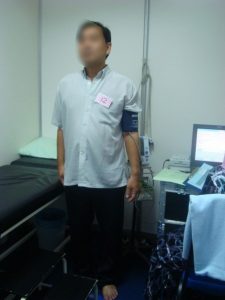
Image 2: The participant’s blood pressure will be measure in standing position.
- The first measurement is taken from the standing position.
- Please do not move and talk while doing measurements.
- Please do not lean against the bed or wall.
- The legs and arms should be parallel to the body when standing upright.
- The measurement will be performed as many as three times automatically.
To get a more accurate result, you need to have enough rest before doing a blood pressure measurement. The measurements will be analysed and verified. After that, a printout of your blood pressure information will be sent to the participants.
Reference value of blood pressure

Reference: The 7th Report of the Joint National Committee on Prevention, Detection, Evaluation, and Treatment of High Blood Pressure, JAMA (2003)
Who needs to carry out the test?
Anyone, who are interested to learn more about their blood pressure.
TEKANAN DARAH
Pengenalan
Tekanan darah merujuk kepada tekanan yang dikenakan oleh darah pada pembuluh arteri darah ketika darah di pam oleh jantung keseluruh anggota tubuh badan manusia.
Maklumat yang direkodkan sebagai persediaan termasuk :
- Disahkan pernah menghidap sebarang penyakit darah tinggi atau darah rendah
- Sudah ambil ubat atau tidak (rekod pengambilan ubat)
- Ada mengalami masalah kesihatan sebelum melakukan pengukuran
Apakah TEKANAN DARAH & Bagaimana ia berfungsi?
Tekanan darah dijalankan dengan memperolehi 2 nilai bacaan seperti berikut – 120 /80 mmhg. Nombor atas (120) menunjukkan tekanan ke atas pembuluh arteri akibat denyutan jantung. Ia dipanggil tekanan sistolik. Nombor bawah (80) menunjukkan tekanan semasa jantung berehat di antara pengepaman, dipanggil tekanan diastolik. Masa yang paling baik untuk mengukur tekanan darah adalah semasa anda rehat dan dalam keadaan duduk atau baring.
Sekiranya tekanan darah didapati sentiasa lebih tinggi dari kadar biasa secara berlarutan seseorang itu dikatakan mengalami masalah darah tinggi. Pesakit darah tinggi mesti sekurang-kurangnya mempunyai tiga bacaan tekanan darah yang melebihi 140/90 mmhg semasa berehat.
Pengukuran tekanan dilakukan dalam 2 posisi dengan 3 kali setiap satu.
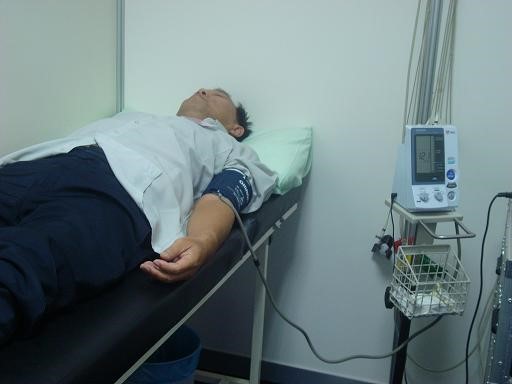
Rajah 1 : Peserta melakukan pengukuran tekanan darah secara berbaring
- Pengukuran pertama diambil dari posisi berbaring di atas katil
- Tidak bergerak dan bercakap semasa melakukan pengukuran.
- kaki dan tangan peserta berada selari dengan badan peserta dan tapak tangan menghadap atas.
- Pengukuran akan dilakukan sebanyak tiga kali secara automatik.

Rajah 2 : Peserta melakukan pengukuran tekanan darah secara berdiri
- Pengukuran pertama diambil dari posisi berdiri
- Tidak bergerak dan bercakap semasa melakukan pengukuran.
- Tidak menyandar pada katil atau dinding
- Kaki dan tangan peserta berada selari dengan badan peserta dan berdiri dengan tegak
- Pengukuran akan dilakukan sebanyak tiga kali secara automatik
Bagi mendapatkan keputusan yang lebih tepat, anda perlu rehat sebelum membuat pengukuran tekanan darah.Keputusan anda akan dianalisis dan disahkan. Selepas itu, cetakan keputusan yang mengandungi maklumat bacaan tekanan darah akan dihantar kepada anda
NILAI RUJUKAN BAGI TEKANAN DARAH

Siapa yang patut mengambil ujian ini?
Pengukuran ini boleh dijalani oleh sesiapa sahaja kerana ujian ini dapat memberikan maklumat terperinci tentang keadaan tekanan darah anda -
Introduction
The body composition analysis measures the fat, muscle mass, and body water levels in our body. After the analysis, the participants will receive a printed report on:
- Weight management (which includes the ideal weight and some information on weight, fat, and muscle control)
- Nutritional evaluation (such as protein, minerals, and body fats)
- Obesity evaluation (such as body mass index, BMI, and percent body fat, PBF)
- Body balance evaluation and visceral fat area
The analysis is very safe and simple. The participant only needs to stand on the machine for this analysis.
What is body composition analysis and how does it work?
Body composition was analysed using bioelectrical impedance (BIA). Bioelectrical Impedance Analysis (BIA) works by sending a small electrical current into a person and measuring the opposition of that current (impedance/resistance) as it travels throughout the body’s water. The impedance/resistance due to the variation in water content in different parts of your body – like in fat and muscle – will be measured to calculate the body composition.
The machine that we are using are InBody720 Body Composition Analyzer dan InBody770 Body Composition Analyzer.
Apart from that, BMI can also be calculated by entering the height value of the participant.
What is the preparation for the analysis?
Please ensure that the participant:
- Do not wear any pacemaker
- Not in pregnancy
- Fasted for 8 hours (or at least 2 hours)
- Not having any harsh sports before the measurement
- Not wearing any metallic accessories
- Soles and palms are in good condition (no injuries or bandage)
- Need to sterilize the soles and palms (to wet the skin surfaces and to ensure cleanliness)
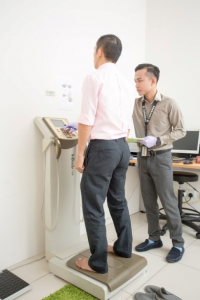

Image 1 : Body posture when carrying out InBody measurement.
During the analysis,
- The participant needs to stand as shown in Image 1.
- The technician will key-in the participant’s data such as SID, height, weight, age, and gender.
- Participant need to stand still for approximately 3 minutes during the analysis to ensure that the results recorded are accurate.
For best results, the participant needs to rest before the analysis. A printed result will be given to the participant once they finished that analysis and the technician will explain the results accordingly.
Note: The InBody analysis could be done every 3-6 months or annually if one wanted to track their body composition changes.
Who needs to carry out the test?
Anyone, who is interested to learn more about their body composition such as the contents of fat, muscle, and water; however, pregnant women and pacemaker wearers should refrain from this analysis.
Pengenalan
Analisis komposisi badan ialah pengukuran yang dijalankan bagi mengenalpasti komponen di dalam badan seperti kandungan lemak, protein dan air. Selepas analisis tersebut, peserta akan memperolehi keputusan:
- Pengawalan berat badan (sasaran berat serta maklumat-maklumat pengawalan berat, lemak dan otot did dalm badan)
- Penilaian nutrisi (protein, mineral dan lemak badan)
- Penilaian obesiti ( BMI, PBF )
- Penilaian keseimbangan badan dan kawasan lemak viseral
Prosedurnya adalah sangat selamat dan mudah. Peserta hanya berdiri di atas mesin untuk menjalankan ujian pengukuran tersebut.
Apakah dia analisis komposisi badan & bagaimana ia berfungsi?
Analisis komposisi badan dijalankan melalui kaedah Bioelectrical impedance analysis (BIA). Sejumlah elektrik dengan kadar yang lemah dan selamat akan dialirkan melalui elektrod pada tapak tangan serta tapak kaki. Pengiraan kadar rintangan akan dapat mengenalpasti jenis komponen seperti lemak, protein dan air.
Peralatan yang digunakan ialah InBody720 Body Composition Analyzer dan InBody770 Body Composition Analyzer.
Selain itu, pengiraan indeks jisim tubuh (body mass index, BMI) juga dijalankan dengan kemasukan nilai tinggi peserta.
Apakah persediaan bagi prosedur ini?
Pastikan samada :
- Tidak memakai perentak/bateri jantung (Pacemaker)
- Tidak mengandung
- Perlu berpuasa 8 jam ( minimum 2 jam)
- Tidak melakukan aktivivti sukan yang berat sebelum melakukan pengukuran
- Tidak memakai sebarang aksesori berlogam
- Tapak tangan dan tapak kaki dalam keadaan baik (tiada luka / balutan)
- Perlu mensteril di bahagian tapak tangan dan kaki dengan tisu basah (supaya permukaan kulit bersih dan tidak kering)


Rajah 1 : Posisi badan peserta semasa pengukuran InBody dilakukan.
Semasa pengukuran
- Peserta perlu naik di atas mesin seperti gambar rajah 1
- Juruteknik akan memasukkan data seperti SID, ketinggian, berat, umur dan jantina peserta.
- Peserta tidak boleh bergerak lebih kurang 3 minit untuk memastikan bacaan direkod dengan tepat.
Bagi mendapatkan keputusan yang lebih tepat, anda perlu rehat sebelum membuat pengukuran InBody / komposisi badan. Keputusan akan dicetak dan diberikan selepas pengukuran dan petugas akan memberi penerangan berkaitan dengan pengukuran tersebut.
Nota: Analisis ini boleh dilakukan setiap 3-6 bulan atau setiap tahun jika anda ingin memantau perubahan pada parameter tertentu seperti melihat keadaan komposisi badan
Siapa yang patut mengambil ujian ini?
Pengukuran ini boleh dijalani oleh sesiapa sahaja kecuali (wanita mengandung dan yang memakai bateri jantung) kerana ujian ini dapat memberikan maklumat terperinci tentang keadaan komposisi badan nada.
-
BODY COMPOSITION ANALYSIS USING DEXA
Prepared by: Nurul Ain Mohd Yusuf, Science Officer & Mohd Arman bin Kamaruddin, Senior Science Officer, UMBI
Reviewed by: Dr. Chin Siok Fong, Research Fellow, UMBIIntroduction
The Malaysian Cohort (TMC) project, UKM Medical Molecular Biology Institute (UMBI) through collaborative research with the University of Oxford, UK will offer Body Composition Analysis using Dual X-ray Absorptiometry (DEXA). This analysis is offered to TMC project participants for free beginning September 2020. Participants will be contacted by telephone to set an appointment date. Among the benefits of performing this analysis are:
- The Whole Body Scan valued at RM200 is offered free of charge
- Participants will get the results body composition (percentage of fat and muscle) of the whole body in the form of interactive and colourful display
- The procedure is very safe. Exposure to X-rays is very low, equivalent to exposure to UV rays from the sun
What is DEXA & how does it work?
DEXA is a safe scan that provides a wealth of information on the composition of a person’s body. It provides analysis on the percentage of your body fat, muscle mass and lean body mass. In addition, this test also provides information on the breakdown of the body composition for all body parts.
Here is an example analysis of the DEXA scan:
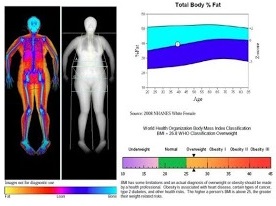
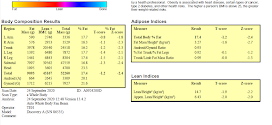
What are the preparations for this procedure?The general criteria to be followed in order to perform the scan:
-
- Not pregnant
- Had not undergone any procedure using counter reagents (such as iodine, barium, etc.) for radiological procedures such as MRI, CT-Scan, PET-Scan within 7 days
- Do not have any iron implants, pacemakers, radioactive seeds or staples, foreign materials such as metal fragments, catheters or opaque tubes in the body
- Height does not exceed 180cm, and weight does not exceed 110kg
For more accurate results, you should make sure that you are well hydrated and not have any food in your stomach (at least three hours from your last meal).
After measuring your height and weight, you will be asked to change into a special gown and lie down comfortably on the scan table. The procedure will be done in a specific closed room, and will take about 4-6 minutes to complete.
Your results will be analysed and verified. The printed result containing information on percentage, mass, and scan images will be sent to you. Note: This analysis can be done every 3-6 months for body composition and every year if you want to monitor changes on a specific parameter.
Who should take this test?This scan can be undergone by anyone as it can provide detailed information about the various components of your body. Athletes can undergo this scan to track their muscle mass as well as their overall fat percentage.
References:
- https://health.ucdavis.edu/sportsmedicine/resources/Assessment%20Information/DXA_Info.html
- https://www.radiologyinfo.org/en/info.cfm?pg=dexa#overview
- https:// https://www.verywellhealth.com/what-is-a-dexa-scan-190167
- http://www.anoc.my/index.cfm?&menuid=20
- Buckinx et. al 2018, Pitfalls in the measurement of muscle mass: a need for a reference standard, Journal of Cachexia, Sarcopenia and Muscle 2018; 9: 269–278
ANALISIS KOMPOSISI BADAN MENGGUNAKAN DEXA
Disediakan oleh: Nurul Ain Mhd Yusuf, Pegawai Sains & Mohd Arman bin Kamaruddin, Pegawai Sains Kanan, UMBI
Disemak oleh: Dr. Chin Siok Fong, Felo Penyelidik UMBIPengenalan
Projek The Malaysian Cohort (TMC), Institut Perubatan Molekul UKM (UMBI) melalui kolaborasi penyelidikan bersama University of Oxford, UK akan menawarkan Analisis Komposisi Badan menggunakan Dual X-ray Absorptometry (DEXA). Analisis ini ditawarkan kepada peserta projek TMC secara percuma bermula September 2020. Peserta akan dihubungi melalui panggilan telefon bagi menetapkan tarikh temujanji. Antara kelebihan melaksanakan analisis ini adalah:
- Imbasan Keseluruhan Badan bernilai RM200 ditawarkan secara percuma
- Peserta akan mendapat keputusan komposisi tubuh badan (peratusan lemak dan otot) bagi keseluruhan badan dalam bentuk paparan interaktif dan berwarna
- Prosedur adalah sangat selamat. Pendedahan kepada sinaran-X adalah sangat rendah, bersamaan dengan pendedahan kepada sinar UV daripada matahari
Apakah DEXA & Bagaimana ia berfungsi?
DEXA adalah imbasan selamat yang memberikan banyak informasi berkenaan komposisi di dalam badan seseorang. Ia memberikan analisis berkenaan peratus lemak dalam tubuh, jisim otot dan jisim tubuh tanpa lemak. Selain itu, ujian ini turut memberikan maklumat pecahan komposisi badan tersebut bagi seluruh bahagian tubuh badan.
Berikut adalah analisis contoh dari imbasan DEXA:


Apakah persediaan bagi prosedur ini?
Kriteria umum yang perlu dipatuhi untuk membolehkan imbasan dijalankan:
- Tidak mengandung
- Tidak menjalani sebarang prosedur yang menggunakan reagen kontra (seperti iodin, barium, dll) bagi prosedur radiologi seperti MRI, CT-Scan, PET-Scan dalam tempoh 7 hari
- Tidak mempunyai sebarang implan besi, perentak jantung (pacemaker), benih radioaktif (radioaktif seeds), kokot pembedahan (surgical staples), bahan asing seperti serpihan logam, kateter atau tiub legap-radio (radio-opaque tubes) dalam badan
- Ketinggian tidak melebihi 180 cm dan berat tidak melebihi 110kg
Bagi mendapatkan keputusan yang lebih tepat, anda perlu memastikan bahawa diri anda terhidrasi dengan baik dan tidak mempunyai sebarang makanan di dalam perut anda (sekurang-kurangnya 3 jam dari pemakanan terakhir anda).
Selepas mengukur ketinggian dan berat badan anda, anda akan diminta menukar kepada persalinan khas dan berbaring dengan selesa di atas meja imbasan. Prosedur imbasan akan dilakukan di dalam bilik khas yang tertutup, dan akan mengambil masa kira-kira 4-6 minit untuk selesai.
Keputusan anda akan dianalisis dan disahkan. Selepas itu, cetakan keputusan yang mengandungi maklumat mengenai peratusan, jisim dan imej imbasan akan dihantar kepada anda. Nota: Analisis ini boleh dilakukan setiap 3-6 bulan untuk komposisi badan, atau setiap tahun jika anda ingin memantau perubahan pada parameter tertentu.
Siapa yang patut mengambil ujian ini?
Imbasan ini boleh dijalani oleh sesiapa sahaja kerana ujian ini dapat memberikan maklumat terperinci tentang pelbagai komponen dalam tubuh anda. Atlet boleh menjalani imbasan ini untuk mengetahui pemetaan jisim otot serta peratusan keseluruhan lemak.
Rujukan:
- https://health.ucdavis.edu/sportsmedicine/resources/Assessment%20Information/DXA_Info.html
- https://www.radiologyinfo.org/en/info.cfm?pg=dexa#overview
- https:// https://www.verywellhealth.com/what-is-a-dexa-scan-190167
- http://www.anoc.my/index.cfm?&menuid=20
- Buckinx et. al 2018, Pitfalls in the measurement of muscle mass: a need for a reference standard, Journal of Cachexia, Sarcopenia and Muscle 2018; 9: 269–278
Introduction
The Malaysian Cohort (TMC) project, UKM Medical Molecular Biology Institute (UMBI) through collaborative research with the University of Dundee, United Kingdom will offer Digital Retinal Imaging using CX-1 Digital Retina Camera. The objective of this study is to identify precisely medicine for diabetic individuals. This analysis is offered to TMC project participants for free at the end of September 2021. Participants will be contacted by telephone to set an appointment date. Among the benefits of performing this analysis are:
- Participants will get the results of the retina in the form of interactive and colorful display
- The Retina Scan is offered for free of charge
- The procedure is very safe and non-invasive
What is CX-1 Digital Retina Camera & how does it work?
The CX-1 Digital Retina Camera is a fully digital hybrid retina camera system with mydriatic and non-mydriatic modes to take picture inside of the eyes. The image capturing is easier and more efficient. The camera is simple to operate to deliver comfortable procedures to the participants.

Who can participate in this project?
- 500 participants that being selected from statistical randomization with history of diabetes
- Participants that willing to undergo the process
What are the effects of the procedure?
- Not harmful for long period of time
- Only side effect in a short time (estimate 4 to 6 hours) of blurry vision
What happened during this procedure?
After measuring your visual acuity and eye condition, dilating eye (by using eye drops) were perform by ophthalmologist to enlarge the pupils of your eyes (estimate time 20-30 minutes). Then, you will proceed to digital retina camera in specific closed room, and will take about 10-15 minutes to complete. Your results will be analyses and verified. The printed result containing information on eye condition and scan images will be sent to you.
IMBASAN RETINA
Pengenalan
Projek The Malaysian Cohort (TMC), Institut Biologi Molekul Perubatan UKM (UMBI) melalui penyelidikan kolaboratif dengan University of Dundee, United Kingdom menawarkan Pengimejan Retina Digital menggunakan Kamera Retina Digital CX-1. Objektif kajian ini adalah untuk mengenal pasti rawatan yang tepat untuk individu pengidap diabetes. Analisis ini ditawarkan kepada peserta projek TMC secara percuma bermula pada akhir September 2021. Peserta akan dihubungi melalui telefon untuk menetapkan tarikh temu janji. Antara faedah melakukan analisis ini adalah:
- Peserta akan mendapatkan hasil retina dalam bentuk paparan interaktif dan berwarna-warni
- Retina Scan ditawarkan secara percuma
- Prosedur ini sangat selamat dan tidak invasive (rumit)
Apa itu CX-1 Digital Retina Camera & bagaimana ia berfungsi?
Kamera Retina Digital CX-1 adalah sistem kamera retina hibrid digital sepenuhnya dengan mod mydriatic dan non-mydriatic untuk mengambil gambar di dalam mata. Pengambilan gambar lebih mudah dan cekap. Kamera ini mudah digunakan untuk memberikan prosedur yang selesa kepada para peserta.

Siapa yang boleh mengambil bahagian dalam Projek ini?
- 500 peserta yang dipilih dari pemilihan rawak secara statistik dengan sejarah diabetes
- Peserta yang bersedia menjalani proses tersebut
Apakah kesan prosedur?
- Tidak berbahaya untuk jangka masa yang panjang
- Hanya kesan sampingan dalam masa yang singkat kepada penglihatan yang agak kabur (anggaran 4 hingga 6 jam)
Apa yang berlaku semasa prosedur ini?
Setelah menilai tahap penglihatan dan keadaan mata anda, pembesaran anak mata (dengan menggunakan titisan mata yang khas) dilakukan oleh pakar oftalmologi (mata) untuk membesarkan pupil mata anda (anggaran masa diperlukan ialah 20-30 minit). Kemudian, anda akan menuju ke kamera retina digital di ruangan tertutup tertentu untuk imbasan mata, dan memerlukan masa sekitar 10-15 minit untuk disiapkan. Hasil pemeriksaan anda akan dianalisis dan disahkan. Cetakan yang mengandungi maklumat mengenai keadaan mata dan gambar imbasan akan dihantar kepada anda.
-
Introduction
Vascular screening gives the value for the condition of the blood vessels in the body. The machine used at The Malaysian Cohort for the test is VASERA VS-1500.
Ways to measure:
- Measurements were taken from the supine position on the bed.
- Please do not move and talk while doing measurements.
- The participant’s feet and hands are on the side of the participant’s body with the palms facing up.
What is vascular screening and how does it work?
Vascular screening meant to monitor and predict the arterial stiffness that presages potential blood circulation disorders. This screening is particularly measure by pressure through 4 points of body (hand and leg).
2 values that are calculated:
- Ankle brachial index (ABI) – Indicator for the degree of vascular narrowing (stenosis)
- Cardio ankle vascular index (CAVI) – Indicator for artery stiffness
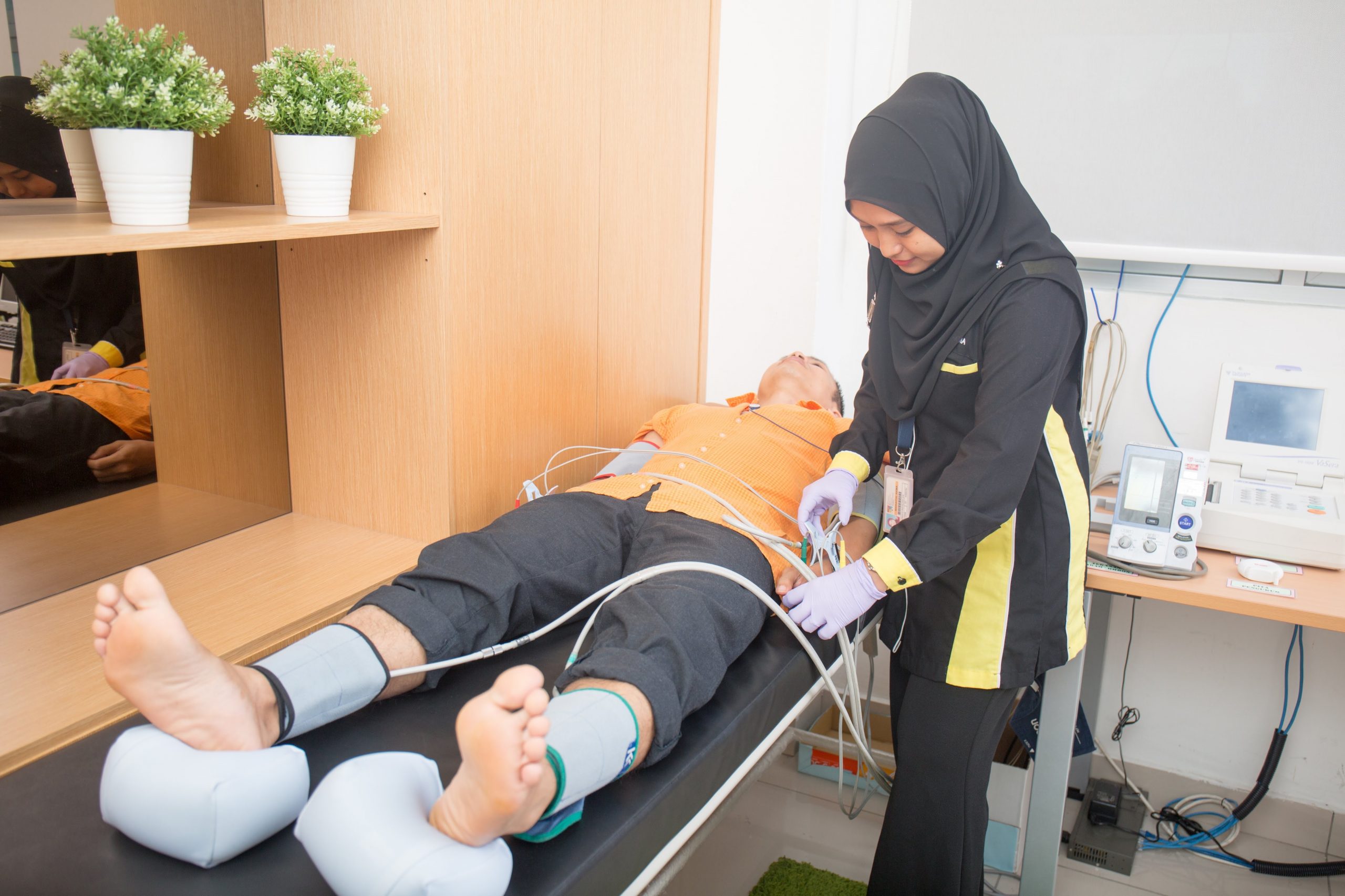
Image 1: Measuring the age of the artery using VASERA.
Preparation before the test
- The vascular screening is performed in a lying position.
- Ankle cuffs and brachial are be placed on the hands and feet of the participants.
- The microphone is placed on the chest.
- The machine will perform the measurements and generate readings.
- The machine will measure the arterial age for both body parts (left and right).
The results will be analysed and verified. After that, a printout of the results containing the useful information regarding the vascular condition will be sent to the participants.
Reference value of VASERA
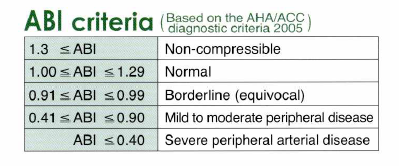
*The ABI criteria were based on the AHA/ACC diagnostic criteria 2005
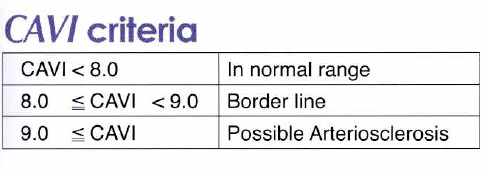
Who needs to carry out the test?
Anyone, who are interested to learn more about their vascular condition.
Pengenalan
Ujian saringan vascular (Vascular screening) atau fungsi salur darah ini memberikan nilai bacaan bagi melihat keadaan salur darah di dalam badan. Mesin yang digunakan di The Malaysian Cohort ialah VASERA VS-1500
Kaedah pengukuran :
- Pengukuran diambil dari posisi berbaring di atas katil
- tidak bergerak dan bercakap semasa melakukan pengukuran.
- kaki dan tangan peserta berada selari dengan badan peserta dan tapak tangan menghadap atas
Apakah fungsi salur darah & bagaimana ia berfungsi?
Ujian saringan vascular (Vascular screening) atau fungsi salur darah membantu bagi mengenalpasti keadaan salur darah melalui nilai bacaan dari tekanan yang disalurkan pada tangan dan kaki peserta. Ujian ini dapat memberi gambaran kekenyalan salur darah dan petunjuk kesempitan.
2 bacaan yang diambil ialah
- Ankle brachial indeks (ABI) – Petunjuk darjah kesempitan (stenosis)
- Cardio ankle vaskular index (CAVI) – Kekerasan ( stiffness )

Rajah 1 : Pengukuran anggaran umur arteri (Vasera)
Persediaan pengurusan adalah seperti rajah 1
- Perlu baring di atas katil.
- Cuff dan penyepit d pasang pada tangan dan kaki peserta.
- Mikrofon di letakkan pada dada.
- Mesin akan melakukan pengukuran untuk mendapatkan bacaan
- Mesin akan melakukan pengukuran anggaran umur arteri bagi kedua-dua belah badan (kiri dan kanan).
Keputusan anda akan dianalisis dan disahkan. Kemudian, cetakan keputusan akan dihantar kepada anda
Rujukan keputusan bagi ujian saringan vascular yang dijalankan


Siapa yang patut mengambil ujian ini?
Pengukuran ini boleh dijalani oleh sesiapa sahaja kerana ujian ini dapat memberikan maklumat terperinci tentang keadaan arteri anda
-
Introduction
Spirometry is a common office test used to assess how well the lungs work by measuring the amount and the speed of air that being inhaled and exhaled. Spirometry is used to diagnose asthma, chronic obstructive pulmonary disease (COPD) and other conditions that affect breathing
Some important considerations before taking the spirometry test:
- Do not take any inhalers or bronchodilators for at least 4 hours prior to measurement.
- Do not smoke or eat for at least 1 hour before measurement.
- Counter check for chronic problems such as heart or lung diseases.
- Do not perform surgery before the test.
- If the participant is wearing dentures/false teeth, kindly ask them to remove it.
If the participant has any mentioned conditions, the information will be record into the form of Electrocardiogram and Spirometry Measurement Manual.
What is spirometry and how does it work?
The lung function test was meant to monitor and assess any respiratory problems that you may encounter. The spirometer tool allows the measurement of the forced expiratory volume at 1 second (FEV1) and the peak expiratory flow (PEF), and hence the measurement of the volume of incoming and outgoing air.
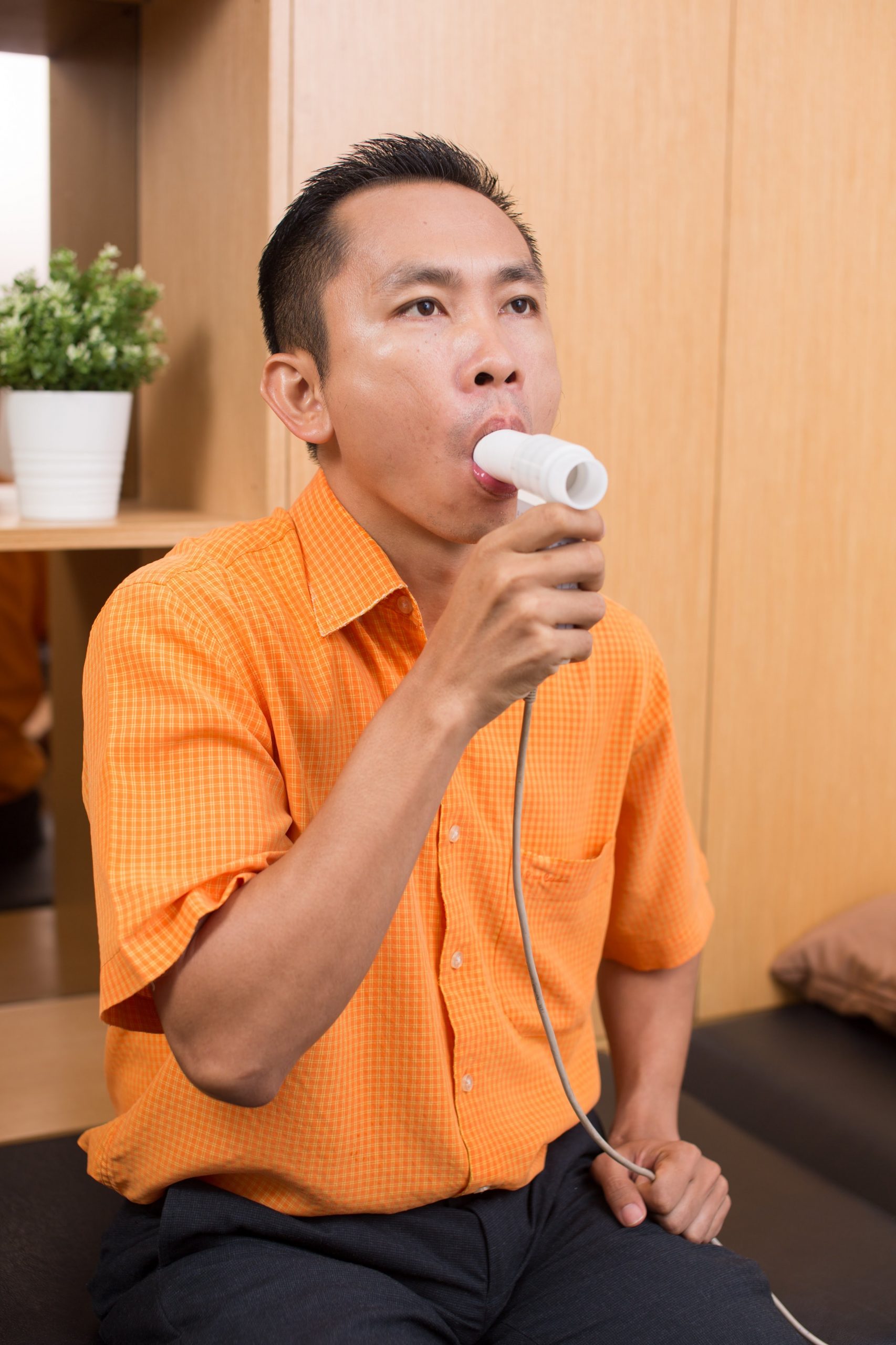
Image 1: A way to use the spirometer.
Preparation before the test
- Sit upright in a chair and with a comfortable position, as shown in Image 1.
- Take a deep breath with your mouth (to fill your lungs with air) and hold the breath.
- Insert the mouthpiece into the mouth and close the mouth tightly, so that there is no air leakage between the mouthpiece and the lip.
- Blow out the breath continuously for about 6 seconds (to force out the air in the lungs).
- After the exhalation, re-inhale to obtain a reading that shows a ‘loop’ on the spirometry graph (mouthpiece should be always in the mouth). Refer to Image 3.
- This test is done at least three times to get the best reading.
To get a more accurate result, the participants need to make sure that they are well hydrated and do not take any meal at least 3 hours before the test.
The results will be analysed and verified. After that, a printout of the results containing the useful information regarding the lung strength will be sent to the participants.
WHO NEEDS TO CARRY OUT THE TEST?
Anyone, who are interested to learn more about their pulmonary strength.
Pengenalan
Pengukuran Spirometri dapat menentukan fungsi dan kekuatan paru -paru samada menarik, menahan dan menghembus nafas.
Pastikan peserta samada:
- Tidak mengambil sebarang inhaler atau broncodilator sekurang kurangnya 4 jam sebelum melakukan pengukuran
- Tidak merokok atau makan berat sekurang-kurangnya 1 jam sebelum pengukuran
- Mempunyai masalah-masalah kronik seperti penyakit jantung atau paru-paru
- Tidak melakukan pembedahan dalam tempoh melakukan ujian
- Sekiranya peserta ada memakai gigi palsu, minta untuk ditanggalkan
Rekodkan dalam Borang Manual Pengukuran Elektrokardiogram & Spirometri sekiranya ada masalah seperti diatas
Apakah SPIROMETRI & Bagaimana ia berfungsi?
Ujian fungsi paru-paru adalah untuk memantau dan menilai sebarang masalah pernafasan yang anda mungkin hadapi. Alat Spirometer membolehkan anda mengukur isi padu paksaan pada 1 saat (forced expiratory volume at 1 second, FEV1) dan arus (peak expiratory flow, PEF) untuk mengukur kuantiti udara yang masuk dan keluar.

Rajah 1: Cara melakukan pengukuran Spirometri.
Apakah persediaan bagi prosedur ini?
- Duduk tegak di kerusi dan dalam keadaan yang selesa seperti rajah 1
- Menarik nafas sedalam-dalamnya dengan mulut (penuhkan paru-paru dengan udara) dan tahan nafas
- Kemudian masukkan mouthpiece ke dalam mulut, tutup mulut dengan rapat supaya tiada kebocoran ruang atau leaking antara mouthpiece dan bibir mulut
- Hembus nafas sekuat-kuatnya selama lebih kurang 6 saat (sehingga tiada udara dalam paru-paru). Hembusan hendaklah berterusan.
- Setelah hembusan dilakukan, dengan serta merta nafas ditarik semula bagi mendapatkan bacaan yang menunjukkan ‘loop’ pada graf spirometri (mouthpiece mesti sentiasa di mulut). Lihat rajah 1.
- Ujian ini dilakukan sebanyak sekurang-kurangnya 3 kali sehingga mendapatkan bacaan yang terbaik
Bagi mendapatkan keputusan yang lebih tepat, anda perlu memastikan bahawa diri anda terhidrasi dengan baik dan tidak mempunyai sebarang makanan di dalam perut anda (sekurang-kurangnya 3 jam dari pemakanan terakhir anda).
Keputusan anda akan dianalisis dan disahkan. Selepas itu, cetakan keputusan yang mengandungi maklumat tahap kekuatan paru paru akan dihantar kepada anda.
Siapa yang patut mengambil ujian ini?
Pengukuran ini boleh dijalani oleh sesiapa sahaja kerana ujian ini dapat memberikan maklumat terperinci tentang tahap kekuatan paru paru anda -
Introduction
An electrocardiogram (ECG) is a preliminary test that is performed to a person who is suspected to have a heart problem. The ECG records the electrical activity generated by the heart muscle through the electrode/wire that is placed on the participant’s chest.
Some important considerations before taking the ECG test:
- Does the participant have a pacemaker?
- Does the participant have implants (iron in the body)?
- Does the participant is certified to have any heart disease prior to the test?
- Does the participant have any heart surgical history prior to the test?
If the participant has any mentioned conditions, the information will be record into the form of Electrocardiogram and Spirometry Measurement Manual.
What is electrocardiogram and how does it work?
An electrocardiogram (EKG) is a test that checks how the heart is functioning by measuring the electrical activity of the heart. It can give us some useful information, for instance, the possible narrowing of the coronary arteries, a heart attack or an irregular heartbeat like atrial fibrillation
The 12-lead ECG test was performed with six electrodes attached to the chest and another four clips on the hands and feet.
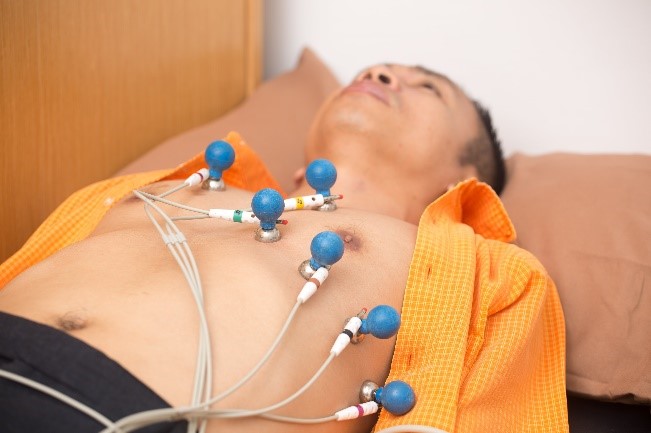
Image 1: The ECG electrode placement in the chest.
Preparation before the test
- Remove all the accessories such as belts, shoes and, socks, as well as everything in the pocket.
- This cardiac examination is performed in a lying position.
- Lose the shirt for the placement of the electrodes on the chest.
- Electrolytes or gels are applied to the skin.
- Participants need to stay calm and motionless.
- The electrodes were placed according to the position as shown in Image 1.
- This test is done at least 3 times to get the best reading.
The results will be analysed and verified. After that, a printout containing the EKG information will be sent to the participants (upon request).
Who needs to carry out the test?
Anyone, who are interested to learn more about their heart/cardiac condition.
* However, this test is generally recommended to specific individuals who have:
- High blood pressure
- Heart valve diseases
- Congenital heart disease (birth defect)
- Irregular heartbeat
- Fainting experience
- Shortness of breath
Pengenalan
Elektrokardiogram (EKG) merupakan ujian awal yang sering dibuat jika seseorang disyaki menghidap masalah jantung. EKG merakamkan aktiviti elektrikal yang dikeluarkan oleh otot jantung melalui melalui elektrod/wayar yang dilekatkan ke atas dada pesakit.
Perkara penting yang perlu dipertimbangkan sebelum menjalani ujian EKG :
- Ada memakai perentak/bateri jantung (Pacemaker)
- Ada memakai implan (besi dalam badan)
- Disahkan pernah menghidap sebarang penyakit berkenaan dengan jantung
- Sejarah pembedahan
Sekiranya mengalami masalah seperti diatas. maklumat akan dicatatkan di dalam Borang Manual Pengukuran Elektrokadiogram
Apakah ELEKTROKARDIOGRAM & Bagaimana ia berfungsi?
Elektrokardiogram (EKG) merupakan rekod aktiviti elektrikal bagi fungsi jantung. Ujian EKG ini adalah untuk mengesan kehadiran penyakit jantung iskemia, penyakit jantung struktur atau keabnormalan ritma degupan jantung. Ujian 12-lead ECG dijalankan dengan pelekatan 6 elektrod di bahagian dada dan 4 klip pada tangan dan kaki.

Rajah 1 : Menentukan kedudukan elektrod di bahagian dada.
Persiapan sebelum menjalani ujian EKG
- Menanggalkan semua aksesori, tali pinggang, kasut dan stokin, serta semua barang dalam poket.
- Pemeriksaan jantung ini dilakukan dalam posisi berbaring
- Menanggalkan baju ataupun buka butang baju sedikit bagi meletakkan elektrod di dada
- Elektrolit atau gel disapukan pada kulit
- Peserta bertenang dan tidak bergerak
- Letakkan posisi elektrod pada peserta mengikut urutan seperti dalam gambar rajah 1
- Ujian ini dilakukan sebanyak sekurang-kurangnya 3 kali atau sehingga mendapatkan bacaan yang terbaik
Keputusan anda akan dianalisis dan disahkan. Selepas itu, cetakan keputusan yang mengandungi maklumat EKG akan dihantar kepada anda ( atas permintaan ).
Siapa yang patut mengambil ujian ini?
Pengukuran ini boleh dijalani oleh sesiapa sahaja kerana ujian ini dapat memberikan maklumat terperinci tentang keadaan jantung anda.
* Secara umumnya, ujian ini disyorkan untuk individu tertentu dengan:
- Tekanan darah tinggi
- Penyakit injap jantung
- Penyakit jantung kongenital (penyakit yang ada sejak lahir)
- Debaran jantung
- Tidak sedar
- Sukar bernafas
-
BODY COMPOSITION ANALYSIS USING MRI (UPDATE : DATA COLLECTION COMPLETED IN APRIL 2022)
Prepared by: Assc. Prof. Dr. Nor Azian Abdul Murad, Director & Research Fellow UMBI
Reviewed by: Assc. Prof. Dr. Rozman Zakaria, Consultant Radiologist, Head of Radiology Department, Faculty of MedicineIntroduction
The Malaysian Cohort (TMC) project, UKM Molecular Medicine Institute (UMBI) through a research collaboration with the University of Oxford, UK will offer Body Composition Analysis using Magnetic Resonance Image (MRI). This analysis is offered to 100 participants of the TMC project for free starting January 2021. Participants will be contacted by telephone to set an appointment date. Among the advantages of performing this analysis are:
- A Whole Body Scan worth RM800 is offered free of charge
- Participants will get the results body composition (percentage of fat and muscle) of the whole body in the form of interactive and colourful display
- The procedure is very safe.
What is MRI & how does it work?
Magnetic resonance imaging (MRI) technique is a safe scan that provides information about the composition in a person’s body. It provides analysis on body fat percentage, muscle mass and lean body mass (similar to DEXA). If DEXA uses X-rays, MRI uses a magnetic field to determine the composition in a person’s body. The MRI machine is a large tube-shaped machine. Participants will be laid on a table and inserted into the MRI machine. A magnetic field will be applied and the image will be processed by a computer. The figure below shows an example of an MRI machine.
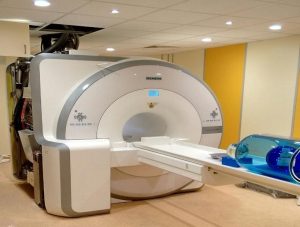
1) MRI Image (https://images.search.yahoo.com/search/images;_ylt=Awr9EmnBzNJfw5IAVxFXNyoA)
What are the preparations for this procedure?
The general criteria in order to perform the scan:
- Not pregnant
- Had not undergone any procedure using counter reagents (such as iodine, barium, etc.) for radiological procedures such as MRI, CT-Scan, PET-Scan within 7 days
- Do not have any iron implants, pacemakers, radioactive seeds or staples, foreign materials such as metal fragments, catheters, or opaque tubes in the body
For more accurate results, you should make sure that you are well hydrated and not have any food in your stomach (at least three hours from your last meal).
You will be asked to wear a special gown and lie down comfortably on the scan table. The scanning procedure will be performed in a closed room and will take about 45 minutes to complete. You are asked not to move much while in the MRI machine. Movement will interfere with the scan resulting in poor-quality images.
The results of body composition analysis will be used to validate the results using DEXA.
What are the risks and side effects of MRI?
MRI technique is a painless radiological method and the advantage of this method is that it does not use x-ray radiation. The side effects of MRI are unknown. However, it is very appropriate and provides accurate data to determine any abnormalities in the body. Participants who know that they have a history of ‘claustrophobia’ (fear of small and confined spaces) may not be able to undergo this MRI test. If participants do not know whether they have ‘claustrophobia’ (fear of small places and confinement), there is a button in the MRI machine that can be pressed to call the staff if you feel uncomfortable / safe to undergo this test.
References:
- MRI Image (https://images.search.yahoo.com/search/images;_ylt=Awr9EmnBzNJfw5IAVxFXNyoA)
- https://www.medicinenet.com/mri_scan/article.htm
ANALISIS KOMPOSISI BADAN MENGGUNAKAN MRI
Disediakan oleh: Prof. Madya Dr. Nor Azian Abdul Murad, Pengarah dan Felo Penyelidik UMBI
Disemak oleh: Prof. Madya Dr. Rozman Zakaria, Pakar Perunding Radiologi, Ketua Jabatan, Jabatan Perkhidmatan Radiologi, Fakulti Perubatan UKMPengenalan
Projek The Malaysian Cohort (TMC), Institut Perubatan Molekul UKM (UMBI) melalui kolaborasi penyelidikan bersama University of Oxford, UK akan menawarkan Analisis Komposisi Badan menggunakan Magnetic Resonance Image (MRI). Analisis ini ditawarkan kepada 100 peserta projek TMC secara percuma bermula Januari 2021. Peserta akan dihubungi melalui panggilan telefon bagi menetapkan tarikh temujanji. Antara kelebihan melaksanakan analisis ini adalah:
- Imbasan Keseluruhan Badan bernilai RM800 ditawarkan secara percuma
- Peserta akan komposisi tubuh (peratusan lemak dan otot) bagi keseluruhan badan dalam bentuk paparan interaktif dan berwarna
- Prosedur adalah sangat selamat.
Apakah MRI & Bagaimana ia berfungsi?
Teknik Magnetic resonance imaging (MRI) adalah imbasan selamat yang memberikan banyak informasi berkenaan komposisi di dalam badan seseorang. Ia memberikan analisis berkenaan peratus lemak dalam tubuh, jisim otot dan jisim tubuh tanpa lemak (sama seperti DEXA). Jika DEXA menggunakan sinaran-X, MRI menggunakan medan magnet untuk menentukan komposisi di dalam badan seseorang. Mesin MRI merupakan mesin yang besar berbentuk tiub. Peserta akan dibaringkan di atas meja dan dimasukkan ke dalam tiub. Medan magnet akan diaplikasi dan imej akan diproses oleh komputer. Gambarajah di bawah menunjukkan contoh mesin MRI

1) Imej MRI (https://images.search.yahoo.com/search/images;_ylt=Awr9EmnBzNJfw5IAVxFXNyoA)
Apakah persediaan bagi prosedur ini?
Kriteria umum yang perlu dipatuhi untuk membolehkan imbasan dijalankan:
- Tidak mengandung
- Tidak menjalani sebarang prosedur yang menggunakan reagen kontra (seperti iodin, barium, dll) bagi prosedur radiologi seperti MRI, CT-Scan, PET-Scan dalam tempoh 7 hari
- Tidak mempunyai sebarang implan besi, perentak jantung (pacemaker), benih radioaktif (radioaktif seeds), kokot pembedahan (surgical staples), bahan asing seperti serpihan logam, kateter atau tiub legap-radio (radio-opaque tubes) dalam badan
Bagi mendapatkan keputusan yang lebih tepat, anda perlu memastikan bahawa diri anda terhidrasi dengan baik dan tidak mempunyai sebarang makanan di dalam perut anda (sekurang-kurangnya 3 jam dari pemakanan terakhir anda).
Anda akan diminta menukar kepada persalinan khas dan berbaring dengan selesa di atas meja imbasan. Prosedur imbasan akan dilakukan di dalam bilik khas yang tertutup, dan akan mengambil masa kira-kira 45 minit untuk selesai. Anda diminta untuk tidak banyak bergerak sepanjang berada di dalam mesin MRI. Pergerakan akan mengganggu imbasan dan imej yang kurang berkualiti akan terhasil.
Keputusan analisis komposisi badan ini adakan digunakan untuk validasi keputusan analisis komposisi badan menggunakan kaedah DEXA.
Apakah risiko dan kesan sampingan MRI?
Teknik MRI merupakan kaedah radiologi yang tidak menyakitkan, mempunyai kelebihan, dan tidak menggunakan radiasi x-ray. Kesan sampingan MRI adalah tidak diketahui. Walau bagaimanapun, ia adalah amat sesuai serta memberikan data yang tepat bagi menentukan keabnormalan di dalam badan. Peserta yang mempunyai sejarah ‘claustrophobia’ (takut kepada tempat kecil dan terkurung) mungkin sesuai menjalani ujian MRI ini. Jika peserta tidak mengetahui samada mereka mempunyai ‘claustrophobia’ (takut kepada tempat kecil dan terkurung), terdapat butang yang boleh ditekan untuk memanggil kakitangan jika anda berasa tidak selesa/ selamat menjalani ujian ini.
Rujukan:


